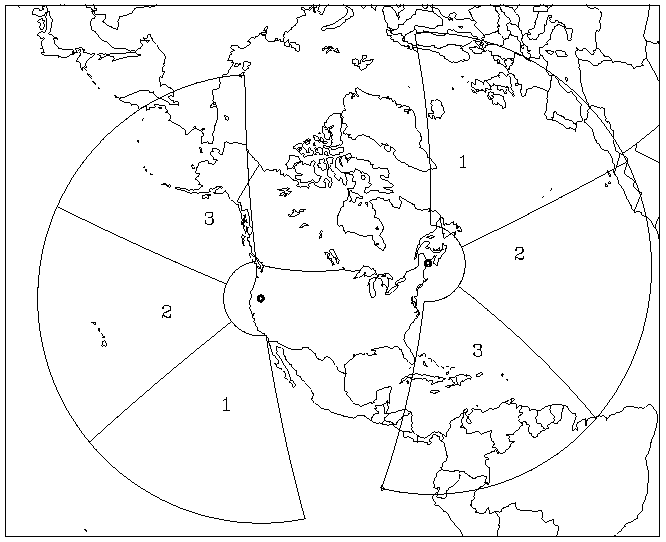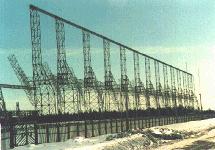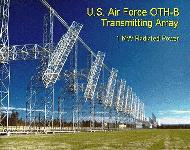





In 1970 Air Force Rome Air Development Center [RADC] engineers developed and constructed components for a frequency modulation/continuous wave (FM/CW) radar capable of detecting and tracking objects at over-the-horizon ranges. The radar installation and evaluation was accomplished on 15 September, while flight tests of a Beverage array antenna were completed on 30 September. On 30 October 1970 the radar and the Beverage array were integrated and operated as a single system for the first time.
The Department of Defense initially planned a central sector radar facing south, and an Alaska System facing north, to complement OTH-B radars on the east and west coast to detect enemy bombers and cruise missiles. With the end of the Cold War the military requirement for the central-sector radar had largely disappeared, and it was being pursued now almost exclusively for the drug interdiction mission. The Congress found this system to be redundant and unnecessary for this effort.
The total value of the ceiling price of that contract for the first and second sectors of the portion of the OTH-B radar program known as the Alaskan System was estimated at $530,000,000. The unexpected cost growth in the deployment of the first sector of the Alaskan OTH-B system defered procurement of the second sector of this system until at least fiscal year 1991. The main reason for the cost growth is the high cost of construction of this type of facility at the site selected by the Air Force. Consequently, the deployment of the Central CONUS system was deferred at least until fiscal year 1992, with land acquisition required no earlier than fiscal year 1991.
With the end of the Cold War, just months after their deployment, the three OTH radars on the West Coast were mothballed, and the incomplete Alaska System cancelled, but the three radars in Maine were redirected to counter-narcotics surveillance. In 1994 the Congress directed the Air Force to continue operating the East Coast OTH-B radar at no less than a 40 hour per week schedule, and to ensure that all OTH-B tracking data was transmitted directly to DOD and civilian agencies responsible for providing counterdrug detection and monitoring support to law enforcement agencies. In order to utilize the full potential of this wide-area sensor, the Congress directed DOD to (1) assist the Air Force in linking the East Coast OTH-B radar site data directly to users, including but not limited to the U.S. Customs/Coast Guard C3I Center, Miami; Joint Task Force 4 Operations Center, Key West; U.S. Southern Command Operations Center, Key West; and U.S. Southern Command Operations Center, Panama; and (2) fully cooperate with efforts of other government agencies to utilize the dual-use capabilities of this system for remote environmental and weather monitoring and other purposes.
The Air Force maintains the six East Coast and West Coast OTH-B radars in a state called �warm storage,� which preserves the physical and electrical integrity of the system and permits recall, should a need arise. It would require at least 24 months to bring these first generation OTH-B radars out of caretaker status and into an operational status-if such a decision to do so were made. Major upgrades costing millions of dollars would be necessary to bring the outdated technologies up to modern standards. The incremental cost of operating the East Coast OTH-B system for environmental research and services is about $1.0M to $1.5M per year. The environmental monitoring aspects of the system are unclassified. Similar coverage in the eastern Pacific could be obtained at about the same cost.
In 1991, NOAA recognized the potential of these military relics of the cold war for environmental monitoring and asked the Air Force's permission to look at the part of the radar echo that the Air Force throws away -- the ocean clutter. NOAA's tests showed that this clutter can be processed to extract ocean surface wind direction over huge, data-sparse ocean areas -- vital information that affects climate and the ocean's circulation. Tropical storms and hurricanes were tracked, and a system for delivering radar-derived winds to the National Hurricane Center was developed. The combined coverage of the six OTH-B radars is about 90 million square kilometers of open ocean where few weather instruments exist. Recent tests have also demonstrated OTH radars ability to map ocean currents.
Specifications | |
| Operator | U.S. Air Force, Air Combat Command, Newport News, VA / Lockheed Martin Co. |
| Radar Type | FM/CW Bistatic Doppler |
| Antenna Types | Horizontal Linear Phased Arrays |
| Maximum CW Radiated Power | 1,000,000 W (12 transmitters) |
| Effective Radiated Power | 80 dBW (100 MW) |
| Transmit Array Design | Canted Dipoles, Vertical Backscreen |
| Transmit Frequency | 5-28 MHz in 6 Bands |
| Transmit Array Elements | 12 per band |
| Subarray Apertures | 304, 224,167,123, 92, 68 m |
| Transmit Azimuth Beamwidth (3 dB) | 7.5 deg |
| Transmit Elevation Beam (3-dB points) | 8-33 deg @ 5 MHz, 5-15 deg @ 28 MHZ |
| Transmit Azimuth Beam Steer �30 deg | |
| Receive Array Design | 246 5.4-m Vertical Elements with 20-m Backscreen |
| Receive Frequency | 5-28 MHz in 3 Bands |
| Receive Array Aperture | 1519, 1013, 506 m |
| Number of Active Receive Elements | 82 |
| Receive Azimuth Beamwidth (3 dB) | 1.25 deg (no weighting), 2.5 deg (raised-cosine weighting) |
| Receive Elevation Beam (3-dB points) | 8-33 deg @ 5 MHz, 5-15 deg @ 28 MHZ |
| Receive Azimuth Beam Steer | �30 deg |
| ECRS Receive Location | 44.79 N, 67.79 W |
| ECRS Azimuth Limits (modified) | 31.5-91.5-151.5-211.5 deg East of North |
| ECRS Transmitter-Receiver Separation | 160 km |
| ECRS Operations Center | Bangor ANGB, ME |
| WCRS Receive Location | 41.70 N, 121.18 W |
| WCRS Azimuth Limits (3 segments) | 160-220-280-340 deg East of North |
| WCRS Transmitter-Receiver Separation | 160 km |
| WCRS Operations Center | Mountain Home AFB, ID |
| Waveform Repetition Frequency | 10-60 Hz |
| Waveform (chirp) Bandwidth | 5-40 kHz |
| Coherent Integration Time | 0.7-20.5 s |



